Dams are a valuable asset. They usually impound water with little input from the owner, and problems that occur usually are minor.
Problems can worsen, however, and can become more expensive to repair if not fixed promptly. When a dam needs work, do it as soon as possible. A minor problem can turn into a major reconstruction project or even result in dam failure. This guide describes actions you should take and items you should check to keep your small dams in good repair.
For the purposes of this guide, small dams are defined as less than 35 feet high and located so that any damage that may occur from dam failure is limited to farm buildings, agricultural land or township and country roads.
Inspections
Inspect a dam the first time a reservoir fills and after unusually large storms, especially those that cause flow through the emergency spillway.
In addition, perform at least one inspection each year. It is a good idea to write down the inspection date, the conditions you find and any actions you take. Use the inspection checklist at the end of this guide for your records.
Erosion control
Good vegetative cover controls erosion on dams and in emergency spillways. Fill in rills and gullies and fertilize, seed and mulch all bare areas. Follow recommendations for fertilizing, seeding and mulching provided with the original drawings and specifications for the dam. You may need to apply fertilizer annually to maintain a vigorous vegetative growth (Figure 1 and 2).
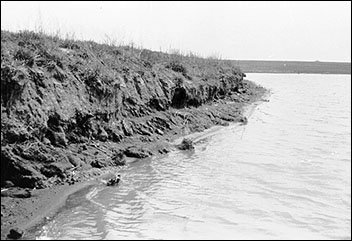

In critical areas where faster restoration of vegetative cover may be required (for example, in the emergency spillway), you may be justified in sodding bare spots.
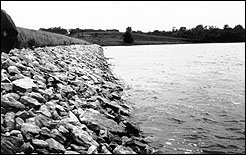
If vegetation will not control erosion at the waterline, consider using rock riprap (Figure 3).
Mow vegetation
Mow vegetation on the dam and emergency spillway to control weeds and to keep trees and brush from becoming established (Figures 4 and 5). Delay mowing until July 15 of each year to avoid destroying nesting wildlife. Cut and remove large, woody vegetation.
Tall, heavy weeds and brush invite undesirable rodent habitation and burrowing.

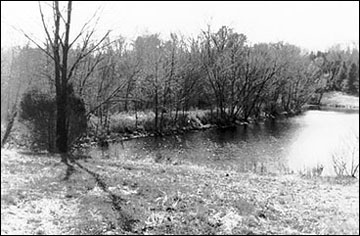
Burrowing animals
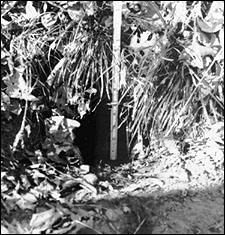
Burrowing animals can cause seepage through a dam, which may lead to dam failure. Fill burrows with compacted soil. It usually is necessary to remove the animals from the area of the dam to control their activities (Figure 6).
Rock riprapping to well below the waterline will discourage muskrat burrowing.
Seepage on downstream side
Unless special drainage features are constructed in the dam, water should not pass through, under or around it.
Pipe spillways
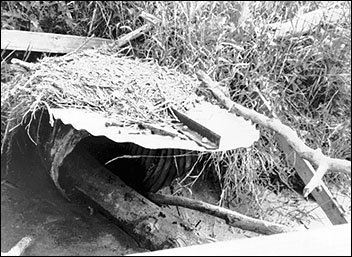
Pipe spillways (the pipe through the dam) can become partially or fully plugged by floating debris. Remove all debris whenever it collects in or around the spillways (Figure 7).
Be sure pipe spillways are sound and properly aligned. Use a small hammer to determine if the pipe wall is weak. Replace pipes that have holes in them. Be sure inlet structures such as trash racks and anti-swirl baffles are firmly attached.
Fences
Fences keep livestock off the dam and emergency spillway and away from the waterline around the pool area. Repair broken-down or worn-out fences (Figures 8 and 9).
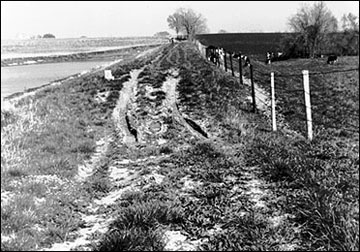
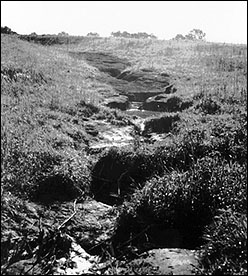
Safety equipment
Be sure ponds used for swimming are equipped with safety devices and are in good condition.
Rebuilding or changing the dam
A dam is designed to fit the specific conditions of its construction site.
Don't change the design dimensions and elevations shown on the drawings without consulting someone familiar with the design and construction of dams.
Changes downstream
Although dam failures are rare, dam design criteria should take into account downstream features that would be damaged if the dam should fail.
The greater the chance of loss of life or damage to valuable property, the safer the design should be. Dams described in this guide are located in rural areas and are classified as "low hazard" dams. If they fail, damage is limited. If additional development occurs downstream, a more hazardous condition could be created if its relationship to the dam and a possible dam failure is not properly considered.
Changes in the watershed upstream
The size of the spillways and the storage volume are based on the expected runoff from the contributing watershed. The runoff is greatly influenced by land features in the watershed.
If significant changes occur in the land features, review the design criteria. Pay special attention to areas with new urban development, which may greatly increase runoff.
Inspection checklist for small dams
| Dam location: | |||||||
|---|---|---|---|---|---|---|---|
| (use a different column for each inspection date) | |||||||
| Date of inspection | |||||||
| Good vegetative cover? | |||||||
| Vegetation mowed? | |||||||
| Vegetation fertilized? | |||||||
| Trees and brush cut? | |||||||
| Rills and gullies repaired? | |||||||
| Shoreline erosion? | |||||||
| Debris around spillways? | |||||||
| Burrowing animals? | |||||||
| Seepage? | |||||||
| Fences adequate? | |||||||
| Safety equipment in place? | |||||||
| Any new construction downstream? | |||||||
| Any notable changes in watershed? | |||||||
| Inspected by? | |||||||
Note
Dams 35 feet or more in height are regulated by the Missouri Dam and Reservoir Safety Council.
For a copy of the rules and regulations of the Missouri Dam and Reservoir Safety Council or other information, contact:
- Dam and Reservoir Safety Program
Missouri Department of Natural Resources
P.0. Box 250
Rolla, Mo. 65402-0250
573-368-2175.